GMC Terrain
Rear Disc Brake Pads Replacement Guide
How to change the rear disc brake pads on
a 1st generation 2010-2016 GMC Terrain with photo illustrated steps.
By Paul B. Michaels Author & Photographer Auto Mechanic Since 1989 |
||
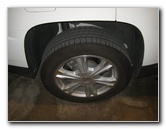 2016 Terrain Rear Wheel |
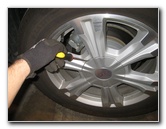 Pry Out Plastic Hub Cap |
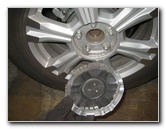 Hub Cover Removed |
| This
automotive maintenance tutorial was specifically written to assist
owners of the first generation (2010, 2011, 2012, 2013, 2014, 2015 &
2016) GMC Terrain in changing the rear disc brake pads and
lubricating the caliper slider pins. Owners of other General Motors vehicles such as the Buick Verano, Regal, LaCrosse, Cascada, Encore, Enclave, Envision, GMC Canyon, Sierra 1500, Acadia, Yukon, Denali, Savana, Spark, Sonic, Cruze, Malibu, Impala, Volt, Camaro, Corvette, SS, Trax, Equinox, Traverse, Tahoe, Suburban, Colorado, Silverado and Express may also find these DIY instructions to be helpful. The tools and other items required to complete this procedure include a flathead screwdriver, a lug nut wrench, a floor jack, two jack stands, a 14mm socket, a 3/8" drive ratcheting wrench, an 17mm wrench, a "C" or "F" clamp and a tube of synthetic brake parts lubricant grease. A few compatible replacement sets of rear brake pads with their part numbers include the following: Wagner QC1275, ACDelco 14D1275CH, Bosch BC1275, Raybestos SGD1275C, ACDelco 171-1011, Centric 102.12750 and Monroe CX1275. |
||
|
|
||
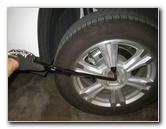 Slightly Loosen Lug Nuts |
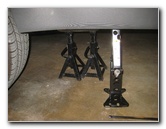 Raise Rear of SUV |
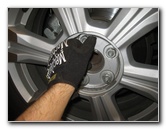 Spin Off Lug Nuts |
| The first two steps
are to park the SUV on a level surface and turn off the engine. Make sure that the parking / emergency brake is not engaged and chock both sides of the front wheels to prevent the vehicle from moving. Use a flathead screwdriver to gently pry out the plastic hub cap on the center of the wheel. There is a small notch where you can insert the blade of the screwdriver. Set the plastic hub cover aside in a safe place. Slightly loosen the five lug nuts by turning them counterclockwise about a 1/4 to a 1/2 turn with a tire iron. Raise the rear of the car with the floor jack and securely support it with the two jack stands. Spin off the 5 lug nuts in the counterclockwise direction. |
||
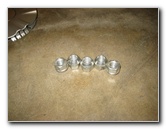 5 Lug Nuts Removed |
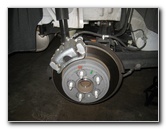 Caliper, Bracket & Rotor |
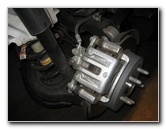 Rear Brake Caliper |
| Set the five lug
nuts aside in a safe place. Remove the rear wheel to reveal the caliper, bracket, rotor and suspension. The rear brake caliper is held in place to the bracket by two bolts on the back side of the caliper. The bolt heads face in towards the center of the SUV. |
||
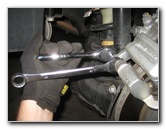 Loosen Bottom Caliper Bolt |
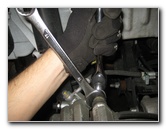 Loosen Top Caliper Bolt |
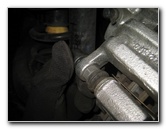 Spin Out Lower Bolt |
| Loosen the bottom
caliper bolt by turning it clockwise (as seen from the outside of the SUV)
with the 14mm socket and 3/8" drive ratcheting wrench. Then loosen the top 14mm caliper bolt by turning it clockwise (as seen from the outside of the car). If the caliper slider pins turn as you are trying to loosen the caliper bolts, hold them in place with a 17mm wrench. |
||
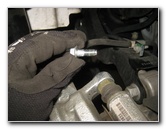 Remove Upper Bolt |
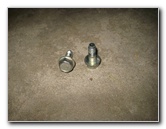 2 Caliper Bolts Removed |
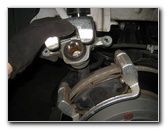 Lift Caliper Out of Bracket |
| Spin out the two
caliper bolts and set them aside in a safe place. Lift the caliper out of the bracket and off the old pads. |
||
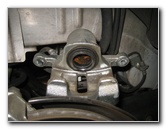 Rest Caliper On Suspension |
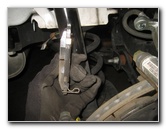 Wear Bar - Bottom Inner Pad |
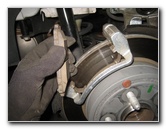 Remove Old Outer Pad |
| Carefully rest the
caliper on the suspension or suspend it from the spring with a bungee cord. Try to avoid kinking, bending, pulling or stressing the rubber brake fluid line in any way. Remove the old inner and outer brake pads from the caliper bracket. Make a mental note of where the wear indicator or "squeal" bar is situated on the old pads. On this 2016 Terrain SLT, the wear bar was located at the bottom of the inner brake pad. I recommend buying the Wagner ThermoQuiet QC1275 rear brake pads since they have excellent review on Amazon. |
||
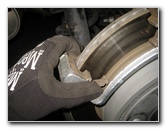 Replace Pad Abutment Clips |
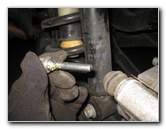 Pull Out Caliper Slider Pins |
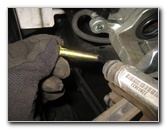 Top Caliper Slider Pin |
If your new set of pads included replacement brake hardware, remove the old pad abutment or "anti-rattle" clips out of the top and bottom of the bracket. Apply a small amount of brake caliper grease on to the bracket and new pad abutment clips where they will come in contact with each other or with the new brake pads. (Do not apply any grease to the friction surfaces of the rotor.) |
||
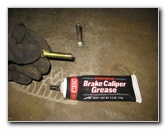 Apply Brake Caliper Grease |
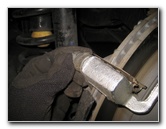 Re-Install Slider Pins |
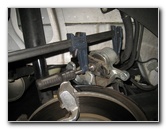 Attach "C" Clamp |
| In order for the
caliper to operate smoothly, the two caliper slider pins or "guide pins"
need to be well lubricated. Pull the two caliper slider pins out of their rubber dust boots at the top and bottom of the bracket. Apply a thin layer of brake parts lubricant grease to each pin before pushing them back in to place. Thoroughly clean off the brake rotor, caliper bracket, brake caliper assembly and the lug nut studs with brake parts cleaner spray. Do not use compressed air or blow with your mouth to clean off the brake parts since breathing in brake dust can be harmful to your health. Brake dust can be carcinogenic (causes cancer) if inhaled.
To remove the existing rotors and install new ones, just remove the single Torx T30 set screw and remove the two 18mm bolts on the rear of the caliper bracket that attach it to the steering knuckle. Then loosen the old rotor with a rubber mallet, pull it off, and slide the new one in its place. (The caliper bracket bolts should be tightened to 92 lb-ft of torque. Or 125 N*m) In order for the caliper to fit over the thicker new brake pads, you'll need to compress back the caliper piston. Attach the "C" clamp to the caliper and use the back of an old brake pad to evenly distribute the pressure across the piston. |
||
|
|
||
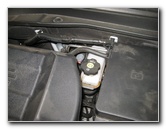 Brake Fluid Reservoir |
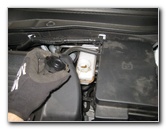 Twist Off Brake Fluid Cap |
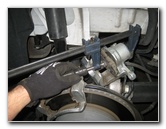 Compress Caliper Piston |
| Move to the right
rear area of the engine bay and twist off the brake fluid cap in the
counterclockwise direction. Removing the reservoir cap will allow the brake fluid to more easily travel back through the system when you compress the piston. Slowly turn the "C" clamp handle to push back the piston until it is flush with the rubber dust boot surrounding it. Try to avoid pinching or damaging the rubber dust boot surrounding the piston. |
||
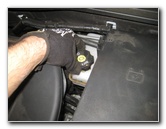 Replace Brake Fluid Cap |
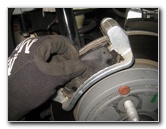 Install New Outer Pad |
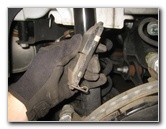 Wear Bar - Bottom Inner Pad |
| Replace the brake
fluid reservoir cap as soon as possible by twisting it on in the clockwise
direction. Brake fluid is hygroscopic so it easily absorbs any moisture in the air which could eventually lead to decreased braking performance. Install the new brake brake pads in to the bracket with the wear indicator bar situated at the bottom of the inner brake pad. |
||
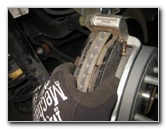 Push Pads Against Rotor |
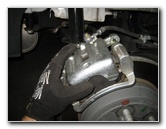 Lower Caliper Over Pads |
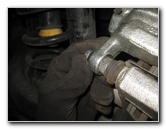 Spin In Bottom Bolt |
| Push the two pads
together until they are flush against the rotor. Carefully lower the brake caliper over the new pads and in to the bracket. Line up the bolt holes in the caliper with their corresponding holes in the slider pins within the bracket. An optional step is to apply some Loctite Blue (medium strength) threadlocker to the caliper bolts to prevent them from vibrating loose. But properly tightened caliper bolts should not become loose. Spin in the two caliper bolts in the counterclockwise direction a few turns to prevent them from becoming cross threaded. |
||
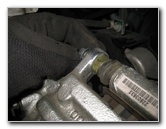 Replace Top Caliper Bolt |
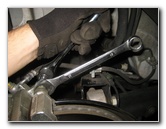 Tighten Caliper Bolts |
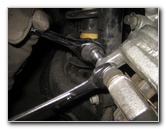 17mm Wrench - Hold Pin |
| Tighten the two
caliper bolts in the counterclockwise direction (as seen from the outside of
the SUV) with the 14mm socket and 3/8" drive ratcheting wrench to just past
hand tight or about 20 ft-lbs of torque. The torque specification in the service manual for the 14mm rear caliper 20 lb-ft (or 27 N*m). If the caliper slider pin turns as you are trying to tighten the caliper bolt, hold it in place with a 17mm wrench. |
||
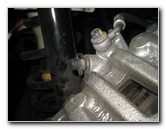 Rubber Valve Cap |
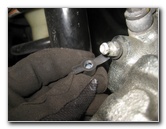 Brake Fluid Bleeder Valve |
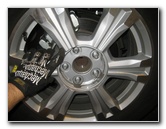 Replace Rear Wheel |
Double check that the two caliper bolts are tight before moving on to the next steps. If your brake pedal previously felt soft, "mushy" or spongy, the brake fluid might be contaminated with water or the brake lines may contain some air bubbles.It would be best to bleed the brake lines at this time in order to flush out the old fluid and replace it with fresh DOT3 brake fluid. For more on this topic, check out my Brake Line Fluid Bleeding With An Assistant DIY Guide or alternatively the Brake Line Fluid Bleeding With A Power Bleeder Guide. |
||
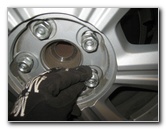 Spin On 5 Lug Nuts |
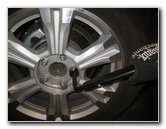 Slightly Tighten Clockwise |
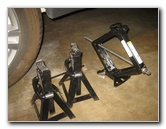 Lower From Jack Stands |
| Replace the rear
wheel and spin on the five lug nuts a few turns by hand in the clockwise direction to
prevent them from becoming cross threaded.
Slightly tighten the five lug nuts in the clockwise direction with the tire iron in a "criss cross" or star pattern. Carefully lower the SUV from the jack stands by using the floor jack. |
||
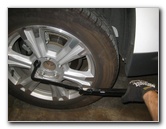 Torque To 140 ft-lbs |
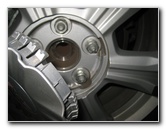 Line Up Plastic Tab |
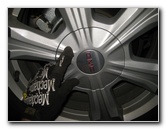 Push On Hub Cover |
Progressively tighten the six lug nuts in a "criss cross" or "star" pattern to about 1/4 to 1/2 turn past hand tight. It would be best to use a torque wrench or an electric impact wrench with a torque stick to tighten the lug nuts to 140 lb ft of torque.Line up the large plastic tab on the back side of the hub cap with the cut out section on the wheel. Gently push the hub cover back in to place until it is flush with the outer face of the wheel. Sit in the driver's seat of the vehicle and firmly push the brake pedal a few times to restore the brake line pressure. Check the brake fluid in the reservoir and verify that it is at the proper level. If it is low, pour in some new DOT 3 fluid. To break in your new rear brake pads, just drive normally for the first several hundred miles while avoiding any hard or "panic" stops which may glaze over the new brake pads and cause them to be noisy and possibly not perform as well. It's also a good idea to regularly check your driveway for drops of brake fluid which may indicate a leak, check the brake fluid level in the reservoir and also check that the lug nuts are still tight. For more,
check out my other
2010-2016 GMC Terrain DIY Repair & Maintenance Guides. |
||
| If you found this guide to be helpful,
please consider making a small donation by clicking on the PayPal.com
"Donate" button located to the right of this paragraph. Thank you!
(Note: I am not a registered charity. Donations are not tax deductible.) |

